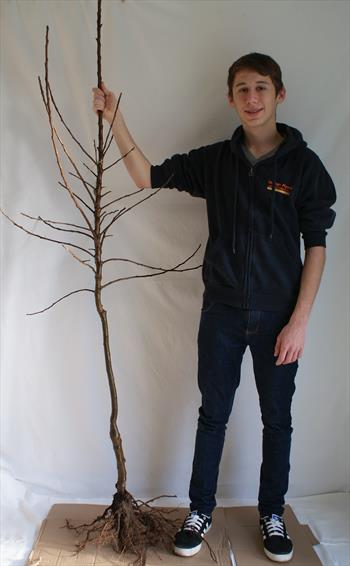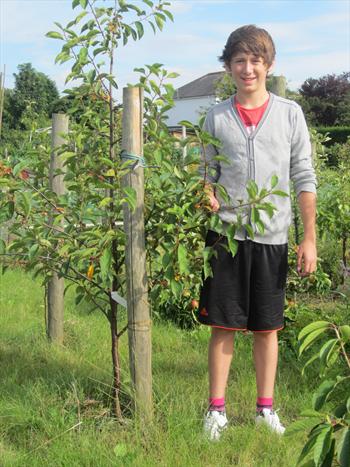The vast majority of fruit trees we sell are trained in forms which are suitable for (and traditional for) gardens and small orchard projects. However from time to time we have small quantities of commercial-grade trees, known variously as spindle-bush or knip-boom trees, which have been carefully trained to meet the very demanding needs of large-scale commercial growers, who require maximum yields from closely planted trees, and with cropping starting from a very early age.

These trees look very different from the tree forms we usually sell, in fact it has to be said they are not very attractive to look at! However that is not the point - if you want a tree that will be very productive and heavy-cropping in a small amount of space, with the potential to produce some fruit in the first year after planting, then these commercial-grade trees may be of interest to you.
Spindlebush or "knip" trees have a number of features which help make them far more productive than a typical garden fruit tree:
- Firstly they are dwarf trees, and stay relatively small (up to 3m tall). Several trees can be planted close together to maximise production in a given space. A general principle is that the tree is trained upwards rather than outwards.
- Unlike a conventional garden fruit tree, the spindlebush tree retains a dominant central stem (central leader). This means the tree grows naturally in the years to come with minimal pruning and shaping required. It also means the fruit is borne on the outside of the tree, where it gets better exposure to light, and hence potentially better quality and flavour.
- You will need a permanent stake for each tree. In fact the stake (or other support) is a crucial component of the spindlebush system, as it means the tree spends more of its energy on fruit production and less on growing a thicker trunk to hold itself up. You can start with a couple of heavy duty bamboo canes, and then add a proper post as the tree gets taller.
- The trees are produced at the nursery over a 3-year cycle, so when you plant them they are already well on the way to maturity, and hence will start producing fruit sooner. (The roots are 3-years old and the tree is 2 years old).
- During the period in the nursery the tree is cut back, and it reacts by producing a large number of wide-angled side shoots, at an optimum height from the ground, providing an early framework for fruit production. It is this process which produces the distinctive but somewhat ungainly double kink in the lower stem, which characterises these trees.
- These trees can be planted very close together. A commercial orchard will plant them in rows with 1m between the trees - but a 2m spacing is probably easier to manage in a garden or small orchard situation, and will still give the potential for very high yields.
- This style of training is particularly suitable for apples, but is also used for cherries, plums, and pears.
 Cherry spindlebush on Gisela 5 rootstock
Cherry spindlebush on Gisela 5 rootstockThere is no single definition of these commerical trees, but you may come across terms such as "spindlebush", "central leader", or "knip-boom" (the latter being simply the Dutch word for "cut tree"). As you may have realised, the science behind the training of commercial fruit trees is far removed from what we normally see in gardens - but the RHS Pruning and Training book has a useful section on "spindlebushes".
We think they are ideal for serious amateur fruit growers and allotment growers.
Here is a list of all our currently-available spindlebush fruit trees.
We sometimes have crab-apples available as spindlebushes. This may seem strange, since why would you want to train a crab-apple in this rather artificial form? The answer is that commercial orchards use crab-apples for pollination, and to keep the orchard layout as efficient as possible these crab-apple trees are planted within the rows of fruiting spindlebush apple trees - so it makes sense for them to also be supplied as spindlebushes.
